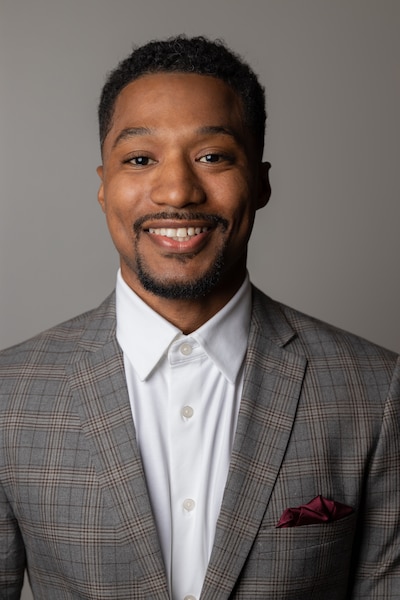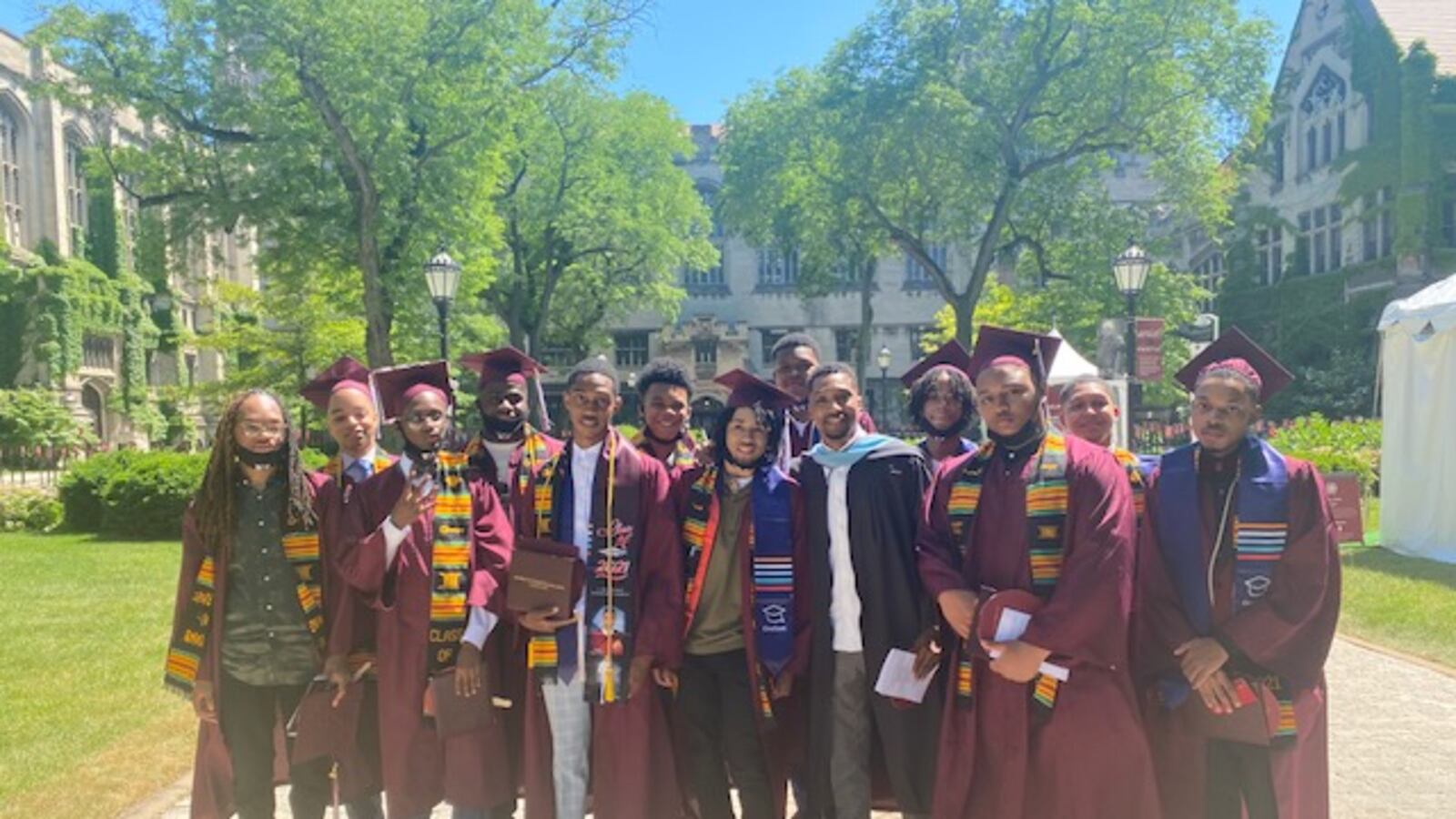While young men and young women walk the same high school hallways, occupy seats right next to one another, and work on the same assignments, data makes it clear that teenage boys in my city do not experience high school the same way as their female peers. That’s significant now, and it has long-term implications.
Record-breaking gender disparities in college enrollment are a national problem, and the phenomenon is playing out here in Chicago. Among Chicago Public Schools students, male students in the class of 2020 were 6 to 14 percentage points less likely than young women of the same race or ethnicity to enroll immediately in a four-year college. And that was among those who completed most of their high school education, and much of the college admissions process, before the pandemic.

Like many other educators, my colleagues and I at the UChicago Charter School Woodlawn Campus, a public charter school on the South Side of Chicago, have searched long and hard for strategies to address the differences in the way our teen boys and girls experience high school. When I joined the school as the director of college counseling in 2018, I felt a sense of urgency to contribute: I had grown up in the neighborhood and attended a CPS high school nearby. I knew that with the right strategies, I could connect high school — and college — to their lived experiences. When I looked at our young men, I saw a part of myself in each of them: They showed grit and longed for interpersonal and school connectedness, even as their academic potential sometimes went untapped.
I questioned how we could tailor our college success and transition curriculum to better support the development of the young men whom we served. I wanted lessons that reflected them and ones designed to help them thrive on and beyond the South Side of Chicago.
I created a cohort of 14 young men at the beginning of their junior year who would take the same college success and transition course together until the end of their senior year. We called the cohort Men with Purpose. It was the school’s first-ever class designed solely for our young men, and the students varied in terms of their GPA and post-secondary aspirations.
The class met daily, and we didn’t shy away from tough topics. We talked, for example, about failure. I wanted to create a culture of vulnerability among the cohort — something that I knew a lot of Black young men don’t experience in high school classrooms.
I wanted lessons that reflected them, and ones designed to help them thrive on and beyond the South Side of Chicago.
One of the first things I learned is that my students felt comfortable being vulnerable in an environment where power was shared. One of the students in the cohort, Kendall, said during an exit interview that was his key takeaway from the class. “You can still teach the curriculum,” Kendall said, “but try to keep all the students involved so that everyone brings their insights to the table, and decisions are made based on those insights. Listen to the students.”
I empowered my students to develop and name the cohort’s values. “We made up the rules instead of a teacher saying, ‘This is going to happen,’” Kendall said. “Everybody said this is going to happen, so we’re going to keep ourselves to it.”
His comment struck me because it demonstrated how strong developmental relationships play a role in persistence, particularly when power in the relationship is shared with students. For me, it reinforced that the relationships can help determine whether or not they believe they can succeed.
I also created the opportunity for students who showed exceptional character, accountability, and humility, among other attributes, to become “fellows,” and I gave fellows lanyards to tangibly mark the recognition of their leadership. I didn’t restrict the number of students in the cohort who could become fellows — my goal was for every student to earn their fellowship. I wanted the selection criteria for a fellowship role to challenge students’ growth.
Kendall was one of the inaugural fellows in our Men with Purpose cohort, but he didn’t remain a fellow the whole year. Here’s how he retold the story to my colleague whom I asked to conduct a few exit interviews near the end of the cohort’s first year.
“See, we were supposed to have this big project done, and we had a lot of time to do it. But by the due date, I still didn’t have it done,” Kendall explained. “But I was a fellow; I was supposed to be one of the leaders of the group. After I went to class, I just took off my lanyard and told him, ‘I can’t really keep this. I’m not showing what a fellow is supposed to be.’”
Hearing him retell this moment was striking because he was holding himself to the standard he had co-created with his classmates and me. It wasn’t that he thought I’d chastise him because he didn’t turn in that one assignment. Kendall expressed feeling so much pride in being a fellow that he didn’t want to let me down.
I also wanted to demonstrate my deep trust in students’ capacity to succeed. Another member of the cohort, Khalil, reflected on this when speaking to my colleague: “One day he was out because his daughter was sick, so he left us with the responsibility to do the work that he left out, so I think that was a moment for him as a teacher to trust us to do the work, and me and a couple of other students made sure we all did the work.”
Hearing Kendall and Khalil’s reflections taught me my second lesson: Students crave opportunities to prove their agency and capacity for leadership not to educators but to themselves.
But what of their grades? One of my primary goals was to help students understand the importance of their GPAs — research shows students’ high school GPAs are a better predictor of their persistence in college than their ACT scores — as well as inspire collective responsibility for one another’s success. If students had demonstrated so much growth when holding themselves accountable, what would happen when they held each other accountable?
Rather than setting individual GPA goals for students, I set a collective GPA goal calculated by averaging together all the students’ GPAs in the cohort. I actively encouraged students to help one another and often assigned them to this work. There was always another student who had an A or B in a class that another student was struggling in, and I would pair them up.
Khalil talked about one cohort classmate in particular when reflecting on whether this had an impact. “In other classes, he started asking more questions. He even had on glasses to help him see the board and read it. … And he started volunteering, too, during our junior year.”
That was the third lesson I learned from my students: When students’ classroom environments promote mutual aid, they impact each others’ academic motivation and confidence.
I’m so proud of my students, not least because their commitment to themselves and one another culminated in quantifiable academic results. During the first semester of our class, the Men with Purpose cohort strived to maintain a collective GPA of 2.7 or above. During the third semester, or the fall semester of the students’ senior year, they were maintaining a collective GPA of 3.7.
Today, Khalil, Kendall, and the other Men with Purpose are in their first year of college, and I find myself reflecting on the time we spent preparing for what they might experience as young Black men at predominantly white institutions.
I told them always to remain confident in who they are and what they represent. Additionally, I reminded them that their presence at PWIs doesn’t mean they must represent all Black people or have answers about the Black struggle. We are multifaceted. The most important thing is that they stay true to themselves.
My work on Men with Purpose has been an honor and privilege, and I’d love to see schools across the country adopt this model of teaching, learning, and college prep. For the past two years, I’ve watched this cohort of young men mature into exceptional human beings. Their perspectives have broadened, and their selflessness has stretched. I am excited to see what’s next for all of them.
Charles Alexander was born and raised on the South Side of Chicago. Charles has over 10 years of experience working in secondary and post-secondary education. Most recently, he served as the director of college counseling at the University of Chicago Charter School’s Woodlawn High School. Charles has a passion for cultivating the minds and talents of marginalized students, with a specific interest in mentoring Black males.



